Rain Intrusion through Horizontal Joints in Façade Panel Systems—Experimental Investigation
Abstract
:1. Introduction
- What is known from existing scientific literature about the raintightness of horizontal joints in façade panel systems?
- How do different joint solutions affect rain intrusion through the horizontal joints in façade panel systems?
2. Methods
2.1. Literature Review
2.2. Laboratory Measurements
2.2.1. Test Set-Up
2.2.2. Rain Testing
3. Results
3.1. Review of Previous Research
3.1.1. Water Distribution
3.1.2. Joint Width
3.1.3. Joint Profiles
3.1.4. Joint Design
3.1.5. Air Cavity
3.1.6. Joint Depth
3.1.7. Air Pressure
3.1.8. Applied Water
3.2. Laboratory Results
3.2.1. Water Distribution between the Wind Barrier and the Interior Side of the Panels
3.2.2. Panel Surfaces
3.2.3. Joint Widths
3.2.4. Joint Profiles
3.2.5. Bevelled Joint Designs
3.2.6. Sealed Top Joint and Water Runoff without Panels
4. Discussion
4.1. Water Distribution between the Wind Barrier and the Interior Side of the Panels
4.2. Panels
4.3. Joint Widths
4.4. Joint Profiles
4.5. Bevelled Joint Designs
4.6. Sealed Top Joints and Water Runoff without Panels
4.7. Other Parameters
5. Conclusions
Author Contributions
Funding
Data Availability Statement
Acknowledgments
Conflicts of Interest
References
- Edvardsen, I.E.; Ramstad, K.I. Trehus, 4th ed.; SINTEF Akademiske Forlag: Oslo, Norway, 2018; ISBN 978-82-536-0919. [Google Scholar]
- Lisø, K.R. Building Envelope Performance Assessments in Harsh Climates: Methods for Geographically Dependent Design. Ph.D. Thesis, Norwegian University of Science and Technology, Trondheim, Norway, 2006; p. 185. [Google Scholar]
- Pachauri, R.K.; Mayer, L. Climate Change 2014: Synthesis Report. Contribution of Working Groups I, II and III to the Fifth Assessment Report of the Intergovernmental Panel on Climate Change; Intergovernmental Panel on Climate Change: Geneva, Switzerland, 2015; ISBN 978-92-9169-143-2. [Google Scholar]
- IPCC. Climate Change 2021: The Physical Science Basis. Contribution of Working Group I to the Sixth Assessment Report of the Intergovernmental Panel on Climate Change; Masson-Delmotte, V., Zhai, P., Pirani, A., Connors, S.L., Péan, C., Berger, S., Caud, N., Chen, Y., Goldfarb, L., Gomis, M.I., et al., Eds.; Cambridge University Press: Cambridge, UK; New York, NY, USA, 2021. [Google Scholar] [CrossRef]
- Hanssen-Bauer, I.; Drange, H.; Førland, E.J.; Roald, L.A.; Børsheim, K.Y.; Hisdal, H.; Lawrence, D.; Nesje, A.; Sandven, S.; Sorteberg, A. Klima i Norge 2100—Kunnskapsgrunnlag for Klimatilpasning Oppdatert i 2015; Norwegian Environmental Agency/Norwegian Climate Service Center: Oslo, Norway, 2015. [Google Scholar]
- Grynning, S.; Gradeci, K.; Gaarder, J.E.; Time, B.; Lohne, J.; Kvande, T. Climate Adaptation in Maintenance Operation and Management of Buildings. Buildings 2020, 10, 107. [Google Scholar] [CrossRef]
- Flæte, O.; Bardalen, A.; Gjærum, I.; Nyeggen, E.; Petkovic, G.; Aanestad, J. Adapting to a Changing Climate—Norway’s Vulnerability and the Need to Adapt to the Impacts of Climate Change; Official Norwegian Reports NOU 2010:10; Norwegian Ministry of the Environment: Oslo, Norway, 2010. (In Norwegian) [Google Scholar]
- Lisø, K.R.; Kvande, T.; Time, B. Climate Adaptation Framework for Moisture-Resilient Buildings in Norway. Energy Procedia 2017, 132, 628–633. [Google Scholar] [CrossRef]
- Recatala, M.A.; Morales, S.G.; Van Den Bossche, N. Experimental Assessment of Rainwater Management of a Ventilated Façade. J. Build. Phys. 2018, 42, 38–67. [Google Scholar] [CrossRef]
- Recatala, M.A.; Morales, S.; Van den Bossche, N. Rain infiltration mechanisms in ventilated façades: Literature review, case studies, understanding common practice flaws. In Proceedings of the 1st International Symposium on Building Pathology (ISBP 2015), Porto, Portugal, 24–27 March 2015; p. 659. [Google Scholar]
- Bøhlerengen, T.; Rolstad, A.N.; Gustavsen, A.; Einstabland, H.; Meløysund, V. Tightening Against Rain and Wind for Facades—Experience from Practice. In Proceedings of the 7th Symposium on Building Physics in the Nordic Countries, Reykjavik, Iceland, 13–15 June 2008. [Google Scholar]
- Geving, S. Kledningsplater til besvær. Byggfakta 2022, 2, 52–54. [Google Scholar]
- Ulvnes, K.; Cadamarteri, F. Må Fjerne Opptil 50 Plater Etter Funn av Råte. adressa.no 2020. Available online: https://www.adressa.no/nyheter/i/28dr1r/ma-fjerne-opptil-50-plater-etter-funn-av-rate (accessed on 27 May 2022).
- Ingebretsen, S.B.; Andenæs, E.; Kvande, T. Microclimate of Air Cavities in Ventilated Roof and Façade Systems in Nordic Climates. Buildings 2022, 12, 683. [Google Scholar] [CrossRef]
- Kvande, T. Totrinnstetning mot Slagregn på Fasader. Luftede Kledninger og Fuger; Byggforskserien 542.003; SINTEF Community: Trondheim, Norway, 2013. [Google Scholar]
- Geving, S. Praktisk Bygningsfysikk, 1st ed.; Fagbokforlaget: Bergen, Norway, 2021; ISBN 978-82-450-2801-0. [Google Scholar]
- Gaarder, J.E. Utvendig Kledning Med Plane Plater; Byggforskserien 542.502; SINTEF Community: Trondheim, Norway, 2019. [Google Scholar]
- Gaarder, J.E. Fasadekledning av Metall; Byggforskserien 542.201; SINTEF Community: Trondheim, Norway, 2019. [Google Scholar]
- Bunkholt, N.S.; Time, B.; Kvande, T. Luftede Kledninger. Anbefalinger for Klimatilpasning; SINTEF Community: Trondheim, Norway, 2021. [Google Scholar]
- Mo, B.H.; Lid, H.S. Slagregninntrenging i Horisontale Fuger på Fasader Med Plane Plater. Master’s Thesis, Norwegian University of Science and Technology, Trondheim, Norway, 2020. [Google Scholar]
- Blocken, B.; Derome, D.; Carmeliet, J. Rainwater runoff from building facades: A review. Build. Environ. 2013, 60, 339–361. [Google Scholar] [CrossRef]
- Blocken, B.; Carmeliet, J. On the accuracy of wind-driven rain measurements on buildings. Build. Environ. 2006, 41, 1798–1810. [Google Scholar] [CrossRef]
- Abuku, M.; Janssen, H.; Poesen, J.; Roels, S. Impact, absorption and evaporation of raindrops on building facades. Build. Environ. 2009, 44, 113–124. [Google Scholar] [CrossRef]
- Park, C.; Park, J.; Kim, N.; Kim, Y. Modeling Water Flow on Façade. Autom. Constr. 2018, 93, 265–279. [Google Scholar] [CrossRef]
- Bielek, M. The main principles of water movement on the wall surfaces of building of various roughnesses. In Proceedings of the RILEM/ASTM/CIB Symposium on Evaluation of the Performance of External Vertical Surfaces of Buildings, Espoo, Finland, 28 August–2 September 1977; Volume 1, pp. 77–96. [Google Scholar]
- Robinson, G.; Baker, M.C. Wind-Driven Rain and Buildings; Technical Paper No. 445; Division of Building Research, National Research Council: Ottawa, ON, Canada, 1975. [Google Scholar]
- Birkeland. General Report on Rain Penetration; Norwegian Building Research Institute: Oslo, Norway, 1966; p. 14. [Google Scholar]
- Van den Bossche, N. Watertightness of Building Components: Principles, Testing and Design Guidelines. Ph.D. Thesis, University of Gent, Gent, Belgium, 2013. [Google Scholar]
- Garden, G.K. Rain Penetration and its Control. In Canadian Building Digest; Division of Building Research, National Research Council of Canada: Ottwawa, ON, Canada, 1963; pp. 401–404. [Google Scholar] [CrossRef]
- Chew, M.Y.L. A modified on-site water chamber tester for masonry walls. Constr. Build. Mater. 2001, 15, 329–337. [Google Scholar] [CrossRef]
- Bassett, M.; Overton, G. Measuring the Weathertight Performance of Flashings. Buildings 2015, 5, 130–148. [Google Scholar] [CrossRef]
- Isaksen, T. Åpne Fuger i Utvendige Kledninger? Norges Byggforskningsinstitutt: Oslo, Norway, 1966. [Google Scholar]
- Isaksen, T. Fugeutforming og Slagregn-Gjennongang; Norges Byggforskningsinstitutt: Oslo, Norway, 1964. [Google Scholar]
- Dordá, P.H.; Pitarch, A.M.R.; Escrig, A.C.; Gurrea, L.M. Water Penetration into Ventilated Facade Joints; Universitat Jaume I: Castellón, Spain, 2010. [Google Scholar]
- Mas, Á.; Gutiérrez, J.; Gil, E.; Gil, A.; Galvañ, V. Design and construction recommendations to improve impermeability in rainscreen walls built with natural stone coverings. Constr. Build. Mater. 2011, 25, 1753–1761. [Google Scholar] [CrossRef]
- Blocken, B.; Carmeliet, J. A simplified numerical model for rainwater runoff on building facades: Possibilities and limitations. Build. Environ. 2012, 53, 59–73. [Google Scholar] [CrossRef]
- Blocken, B.; Carmeliet, J. A review of wind-driven rain research in building science. J. Wind Eng. Ind. Aerodyn. 2004, 92, 1079–1130. [Google Scholar] [CrossRef]
- Bishop, D.; Webster, C.J.D.; Herbert, M.R.M. The Performance of Drained Joints. In Proceedings of the International Symposium on Weathertight Joints for Walls, Oslo, Norway, 25 September 1967; pp. 349–354. [Google Scholar]
- Herbert, M.R.M.; Harrison, H.W. New Ways with Weatherproof Joints; Building Research Establishment: Watford, UK, 1974. [Google Scholar]
- Fernández, M.J. Study of influence of wind pressure and rain conditions in rain screen walls. Struct. Surv. 2010, 28, 46–52. [Google Scholar] [CrossRef]
- Stagrum, A.E.; Andenæs, E.; Kvande, T.; Lohne, J. Climate Change Adaptation Measures for Buildings—A Scoping Review. Sustainability 2020, 12, 1721. [Google Scholar] [CrossRef]
- Arksey, H.; O’Malley, L. Scoping studies: Towards a methodological framework. Int. J. Soc. Res. Methodol. 2005, 8, 19–32. [Google Scholar] [CrossRef]
- Wohlin, C. Guidelines for Snowballing in Systematic Literature Studies and a Replication in Software Engineering. In Proceedings of the 18th International Conference on Evaluation and Assessment in Software Engineering—EASE’14, London, UK, 13–14 May 2014; ACM Press: London, UK, 2014; pp. 1–10. [Google Scholar]
- NS-EN 1027:2016; Windows and Doors—Water Tightness—Test Method. Standards Norway: Oslo, Norway, 2016.
- Van Linden, S.; Van Den Bossche, N. Review of Rainwater Infiltration Rates in Wall Assemblies. Build. Environ. 2022, 219, 109213. [Google Scholar] [CrossRef]

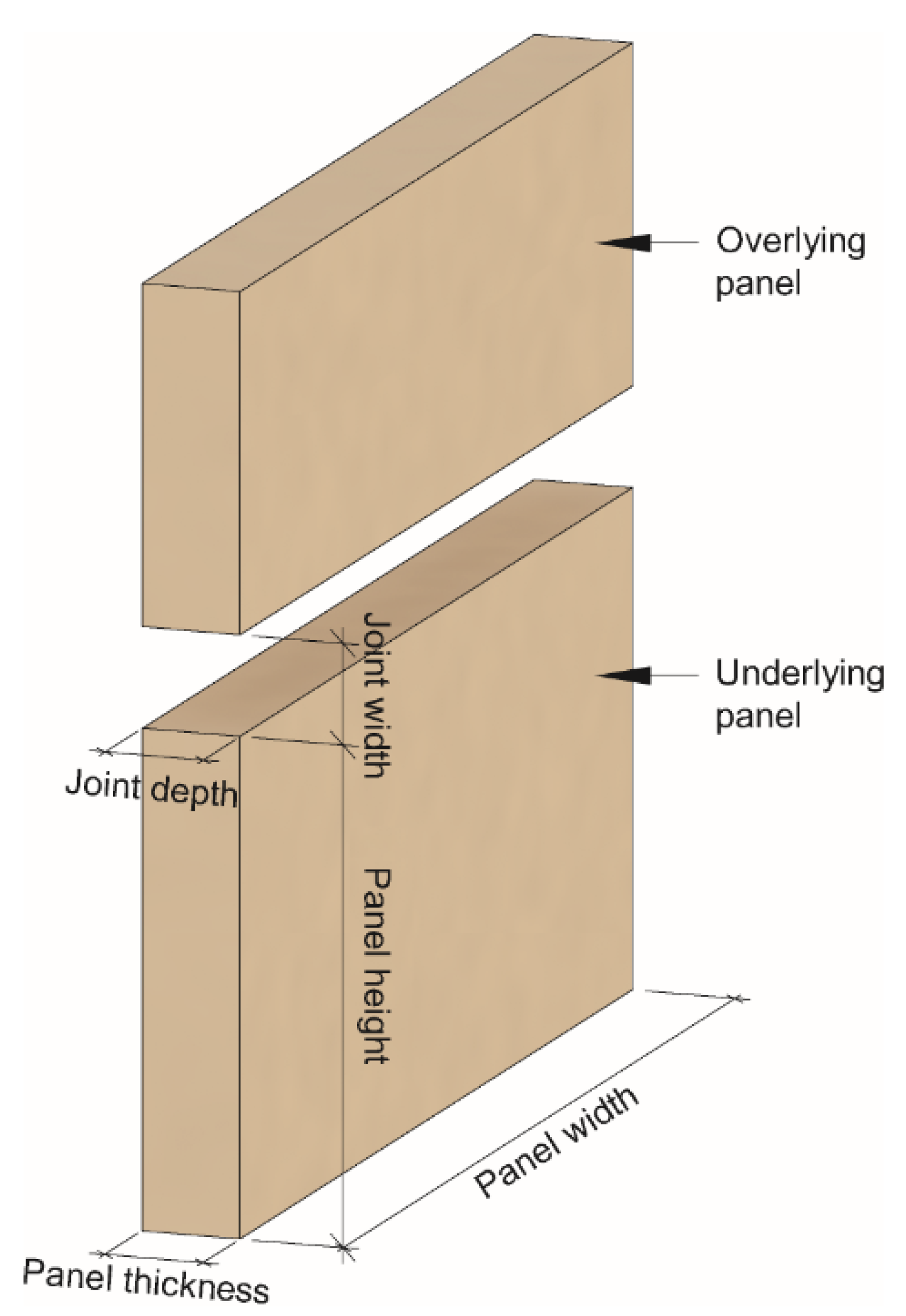
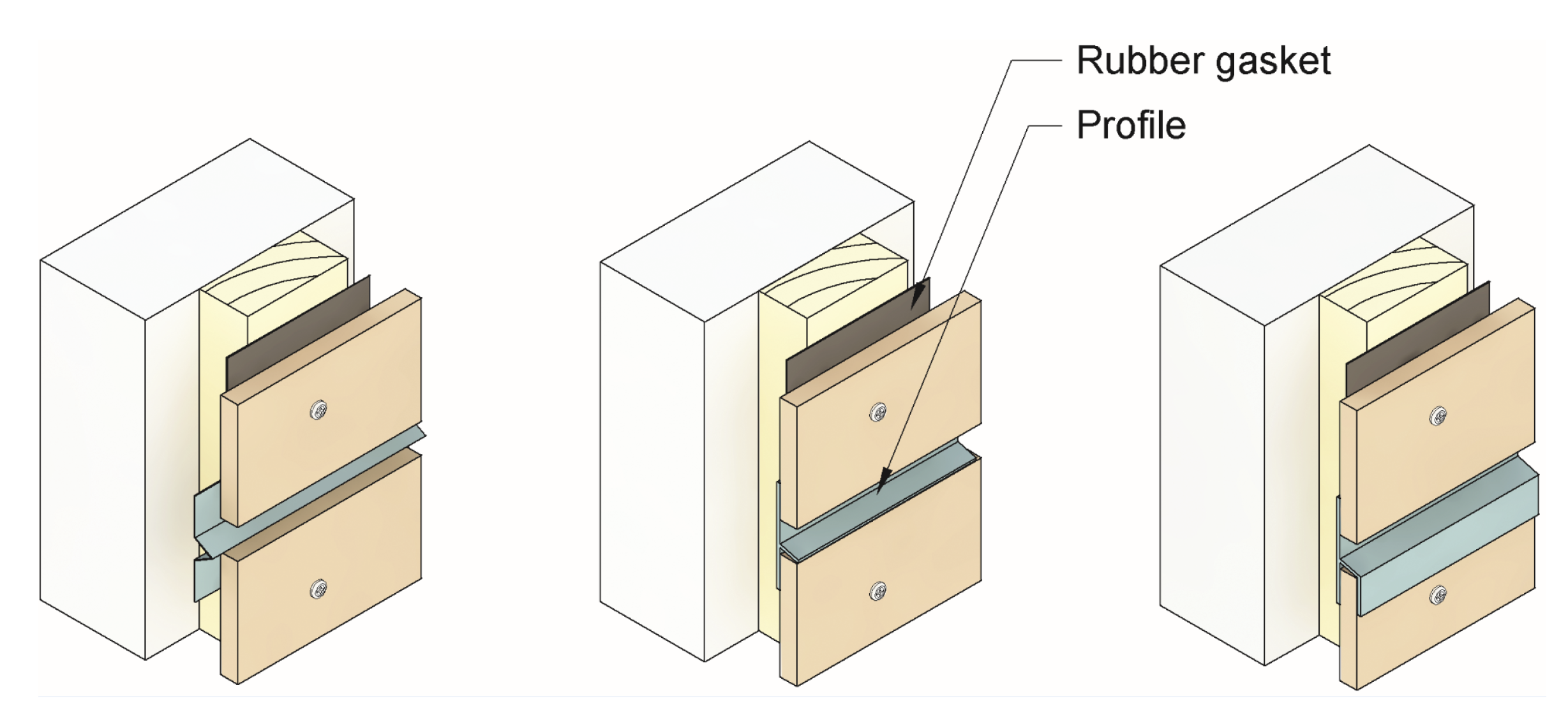
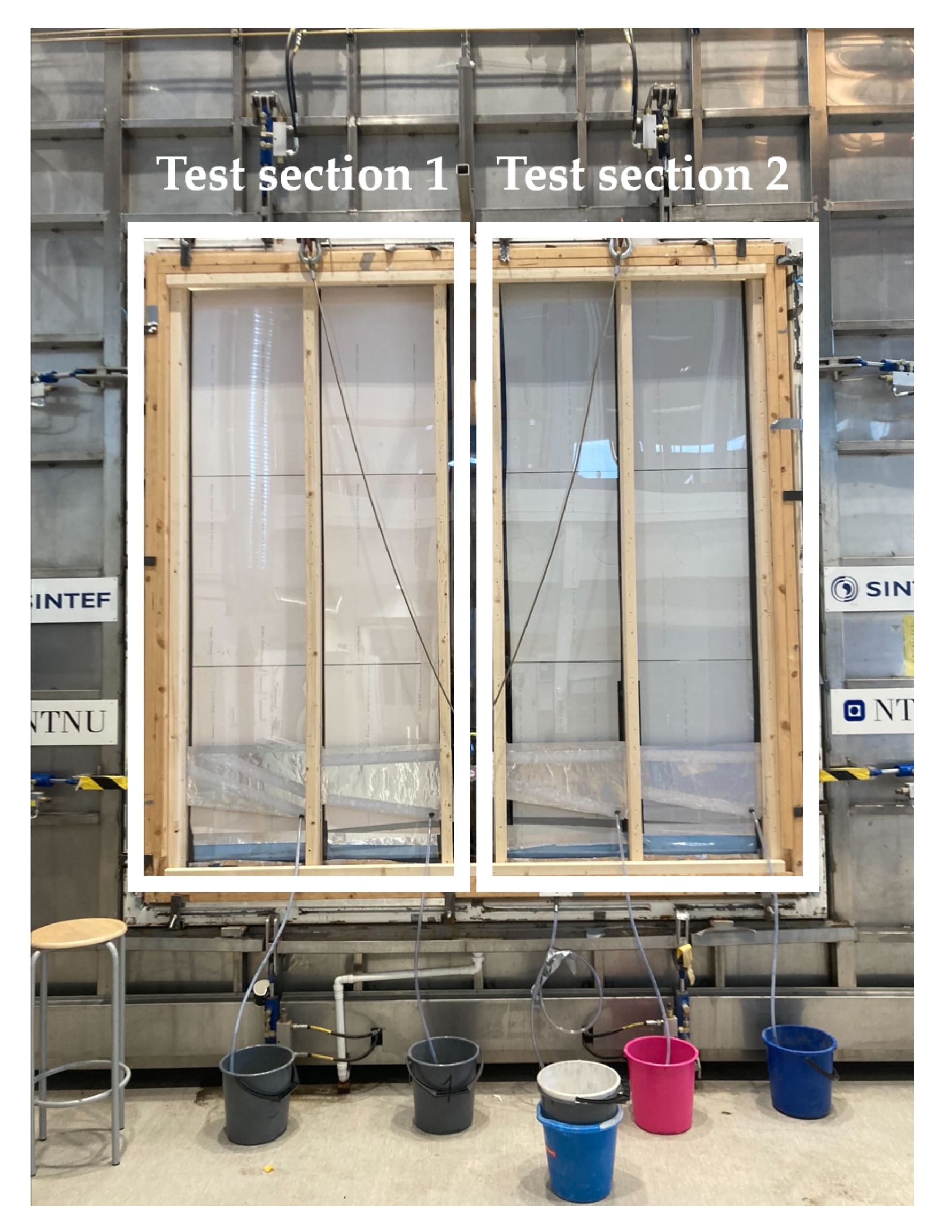
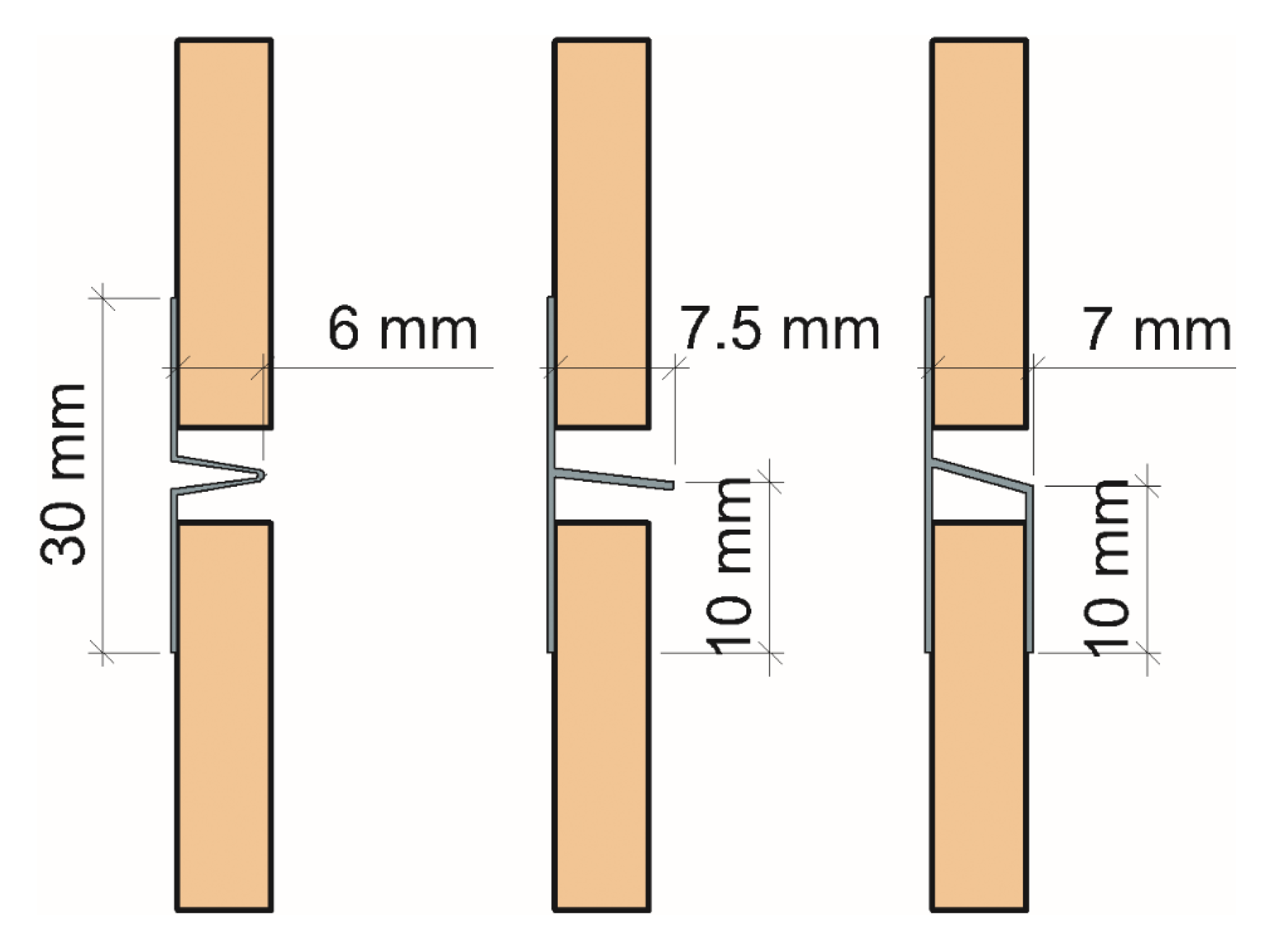
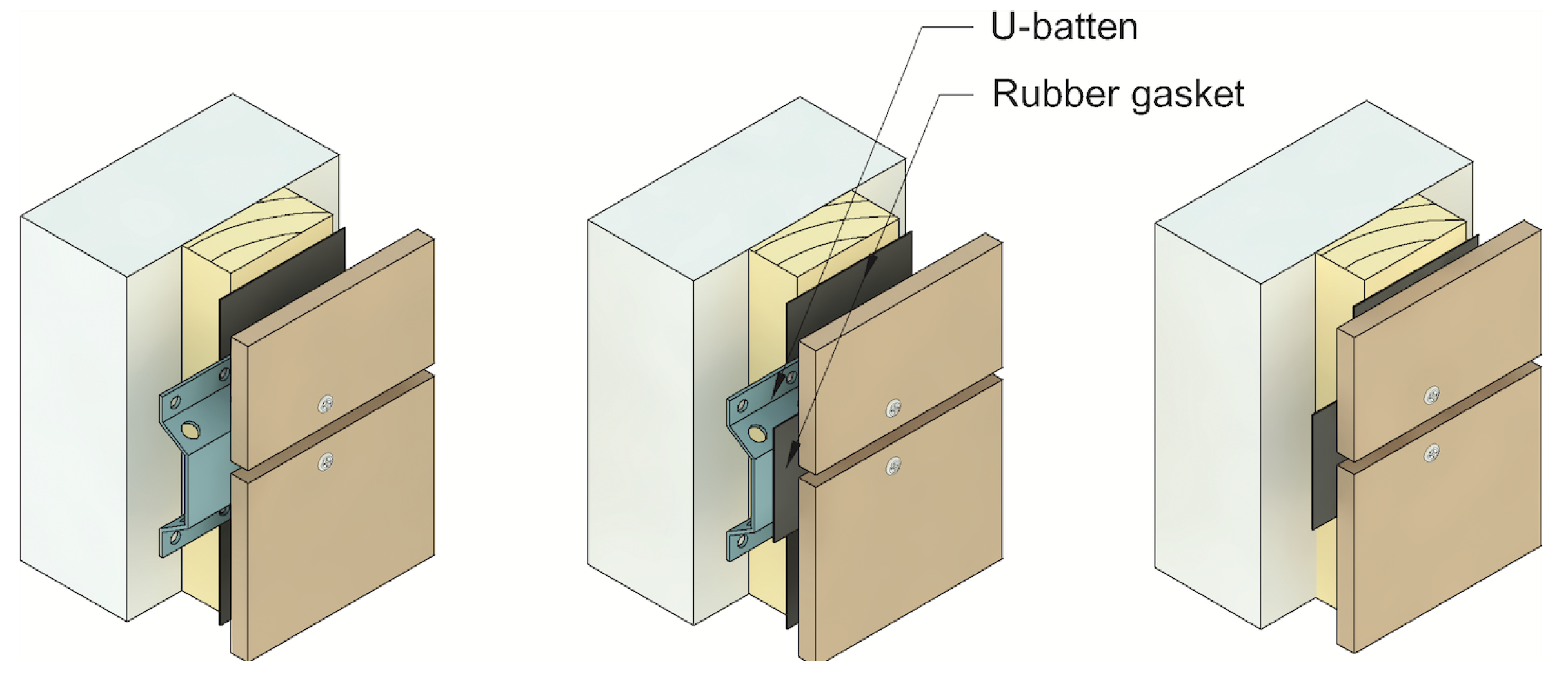
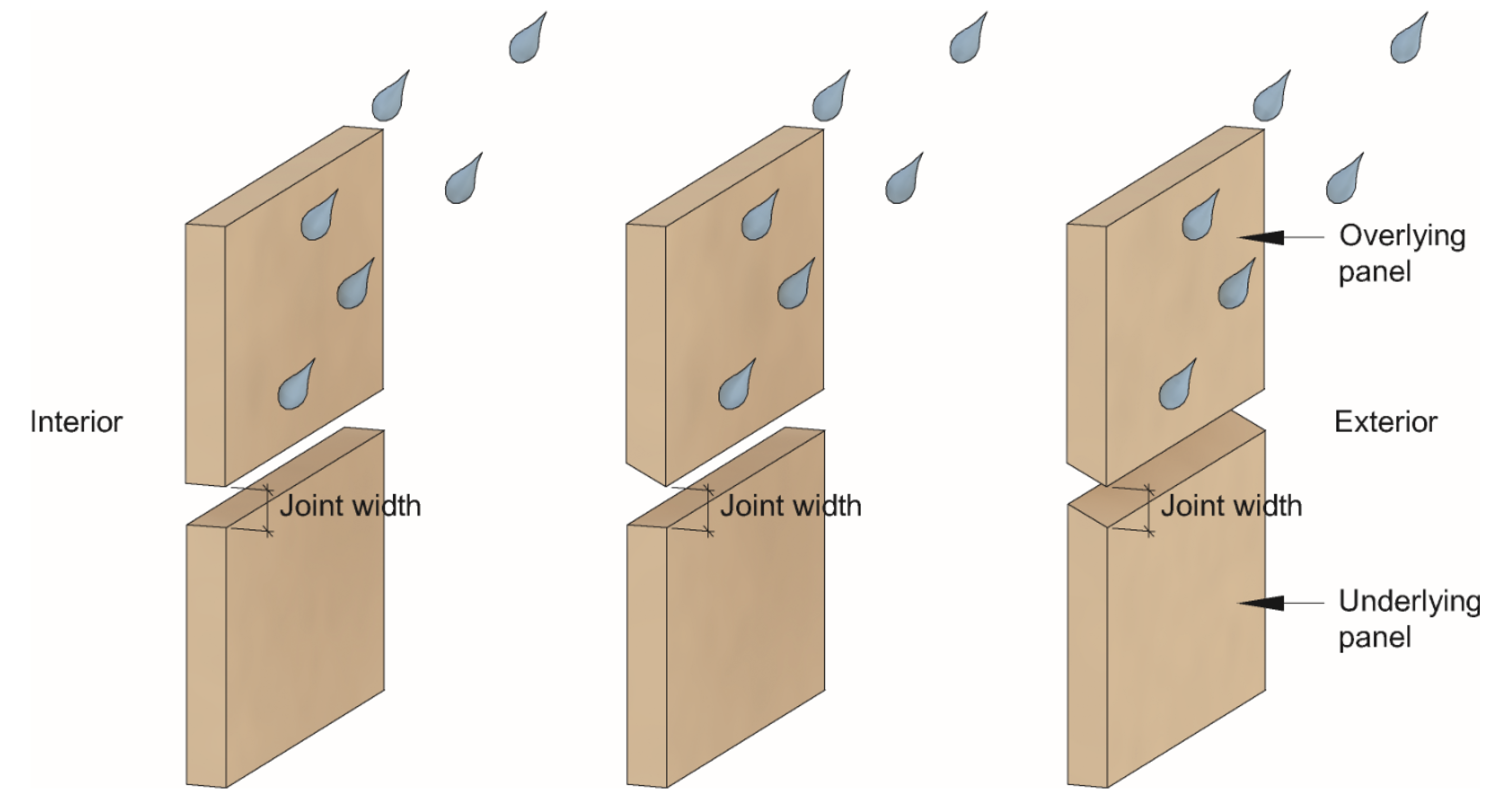
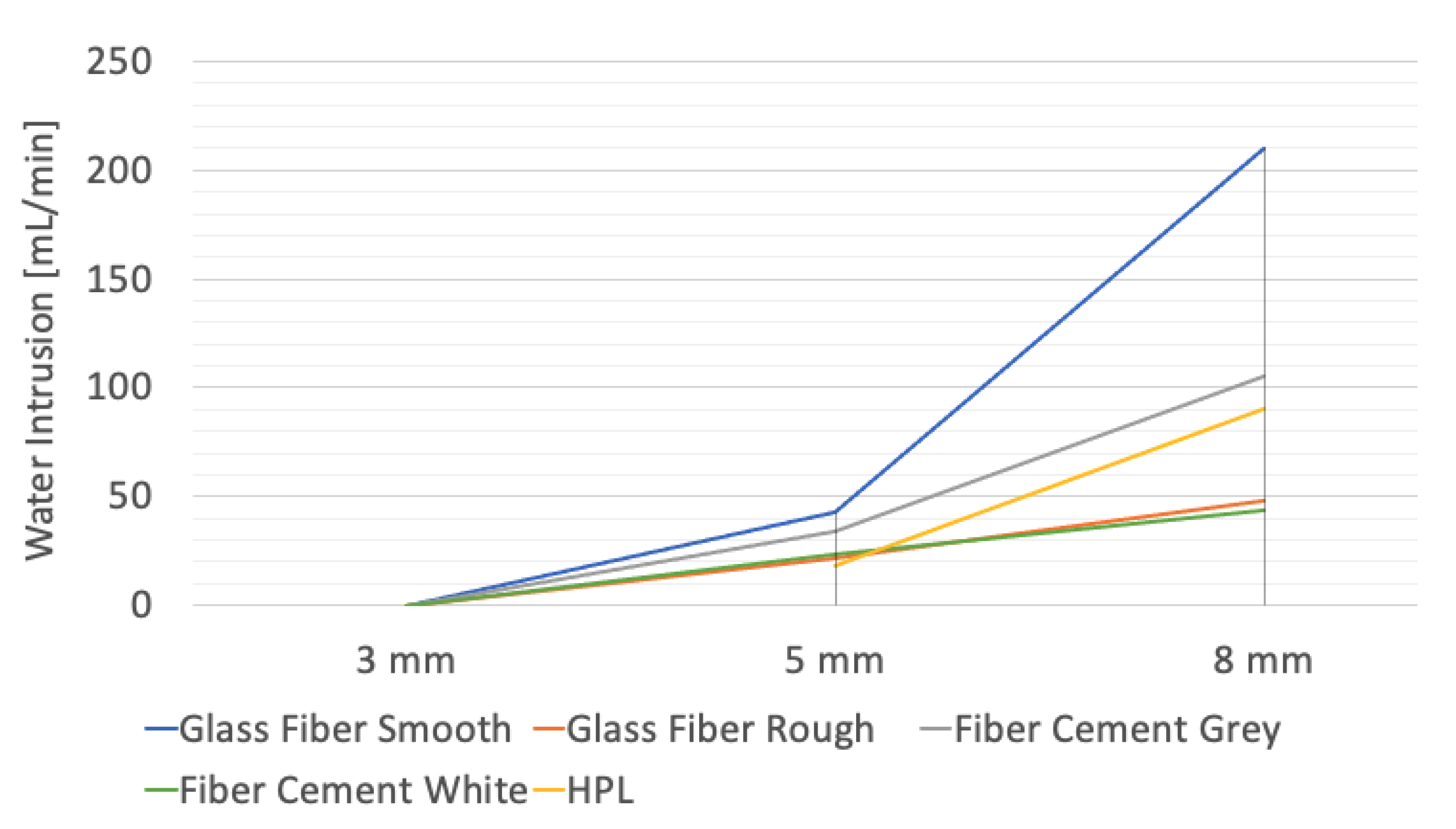
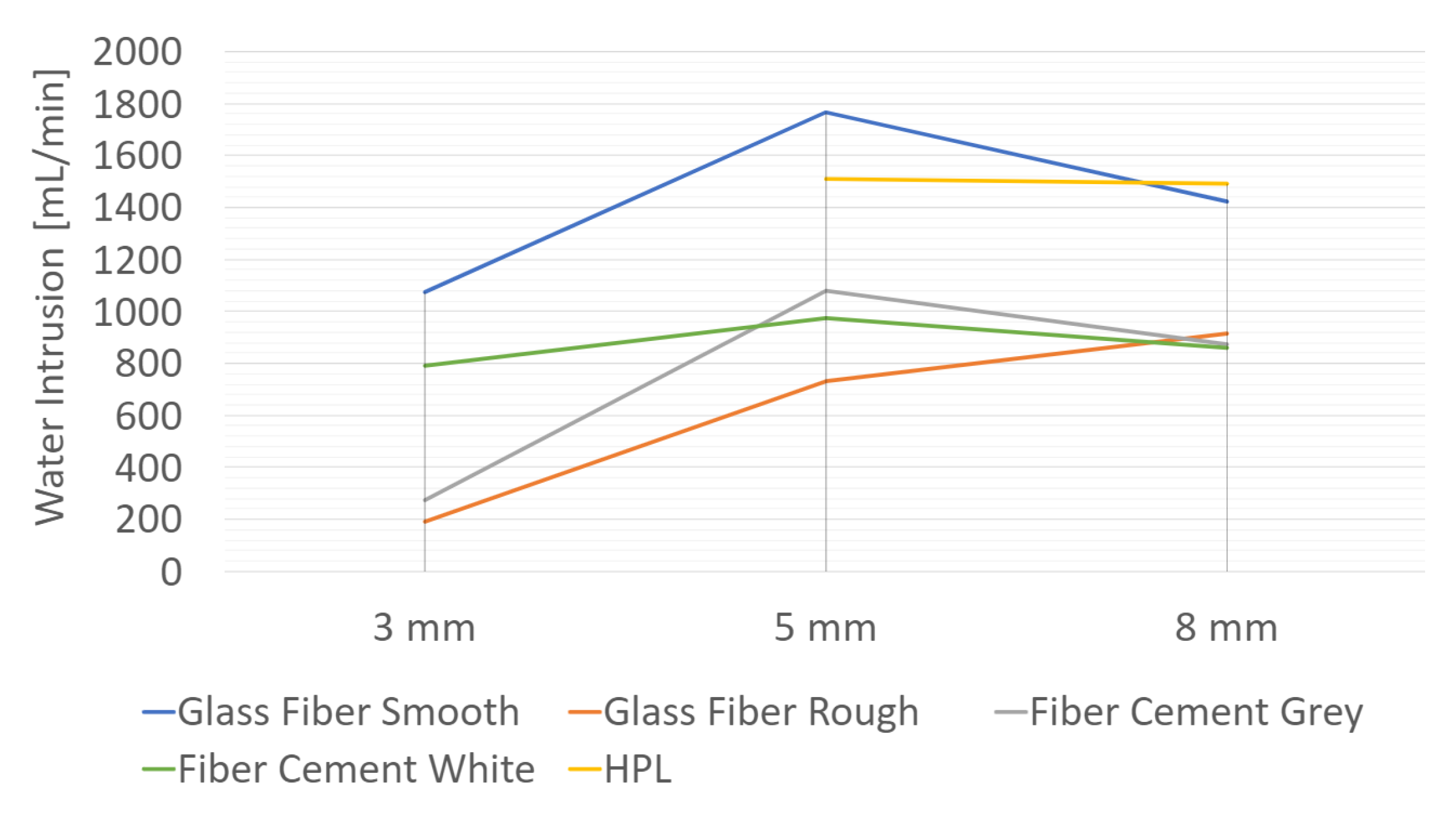

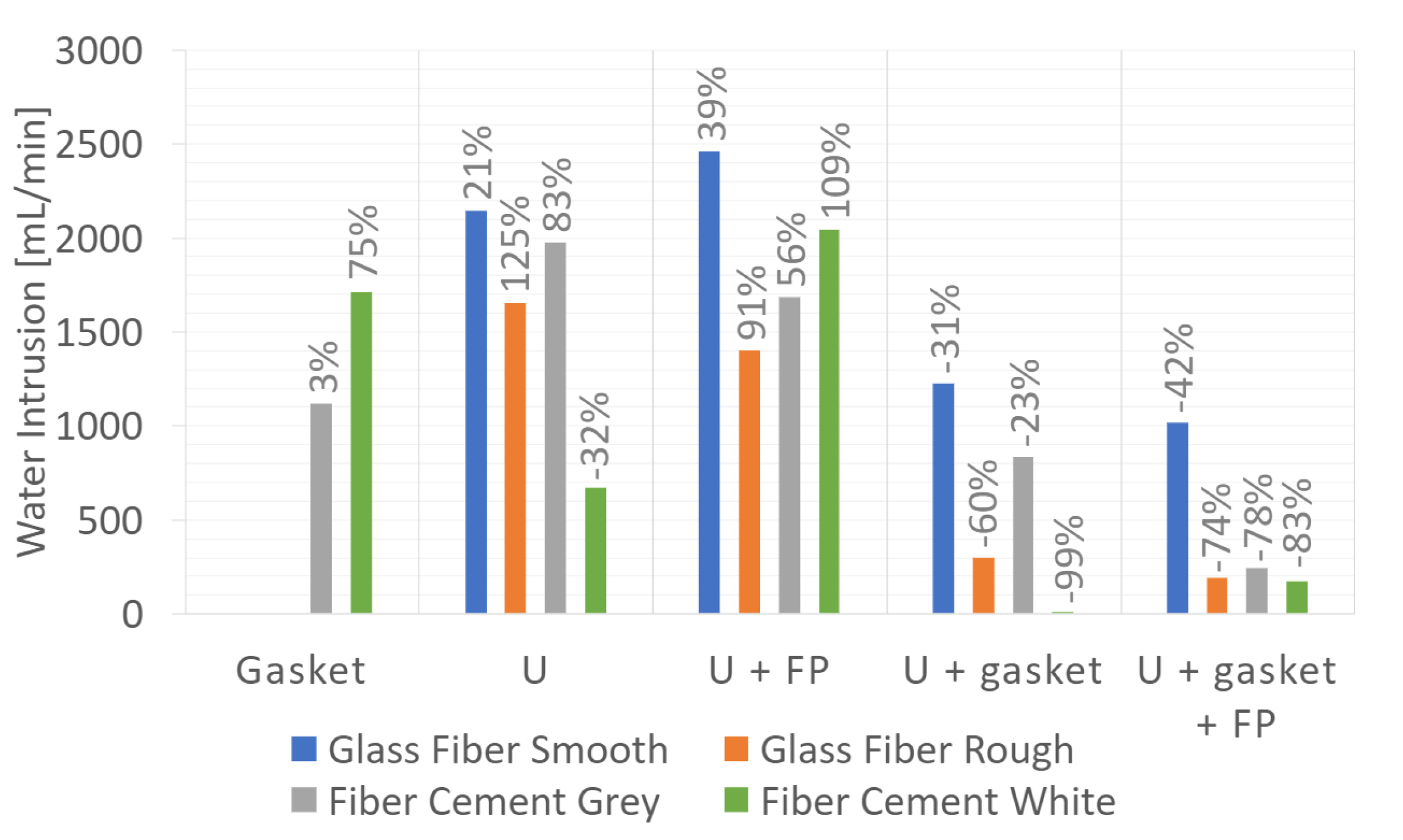
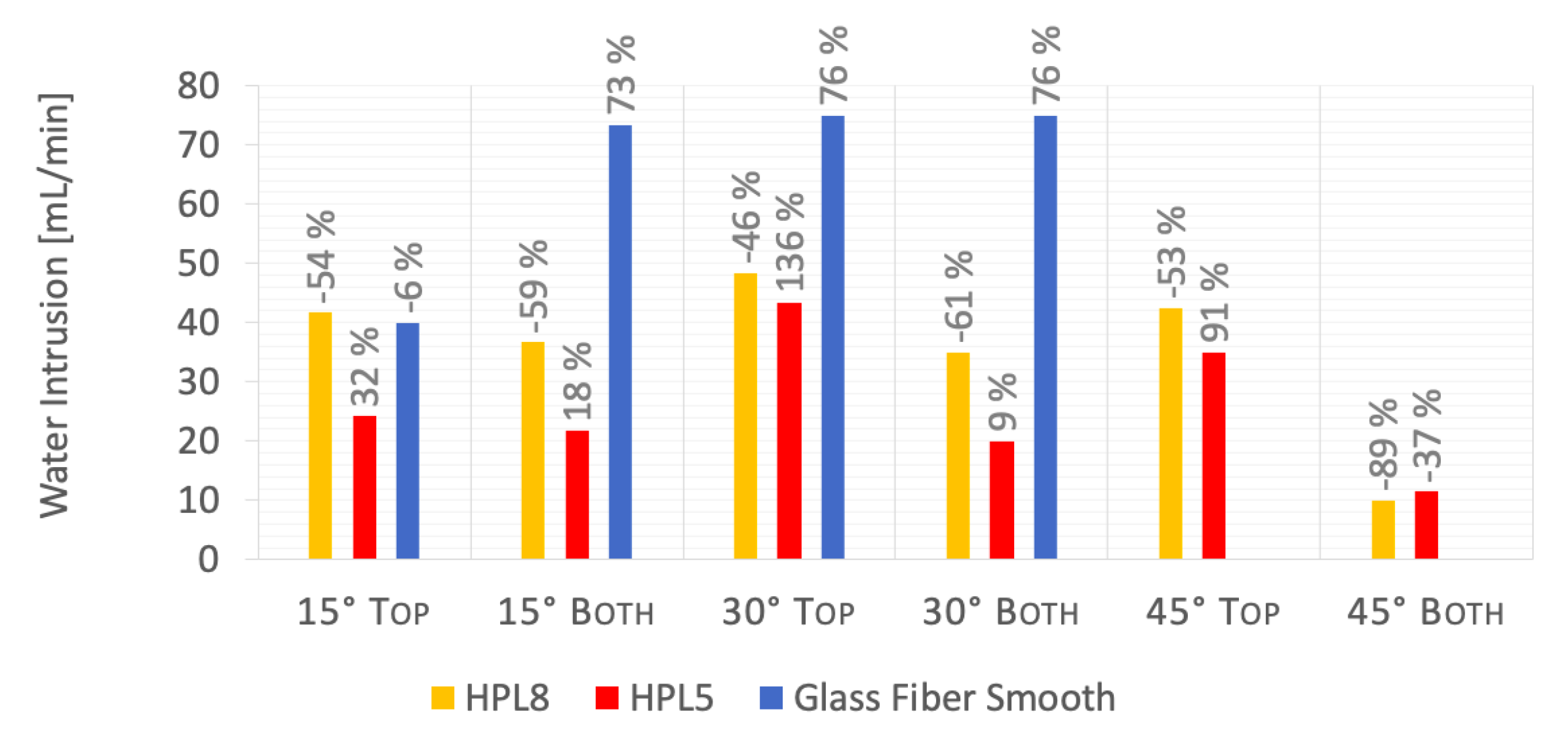

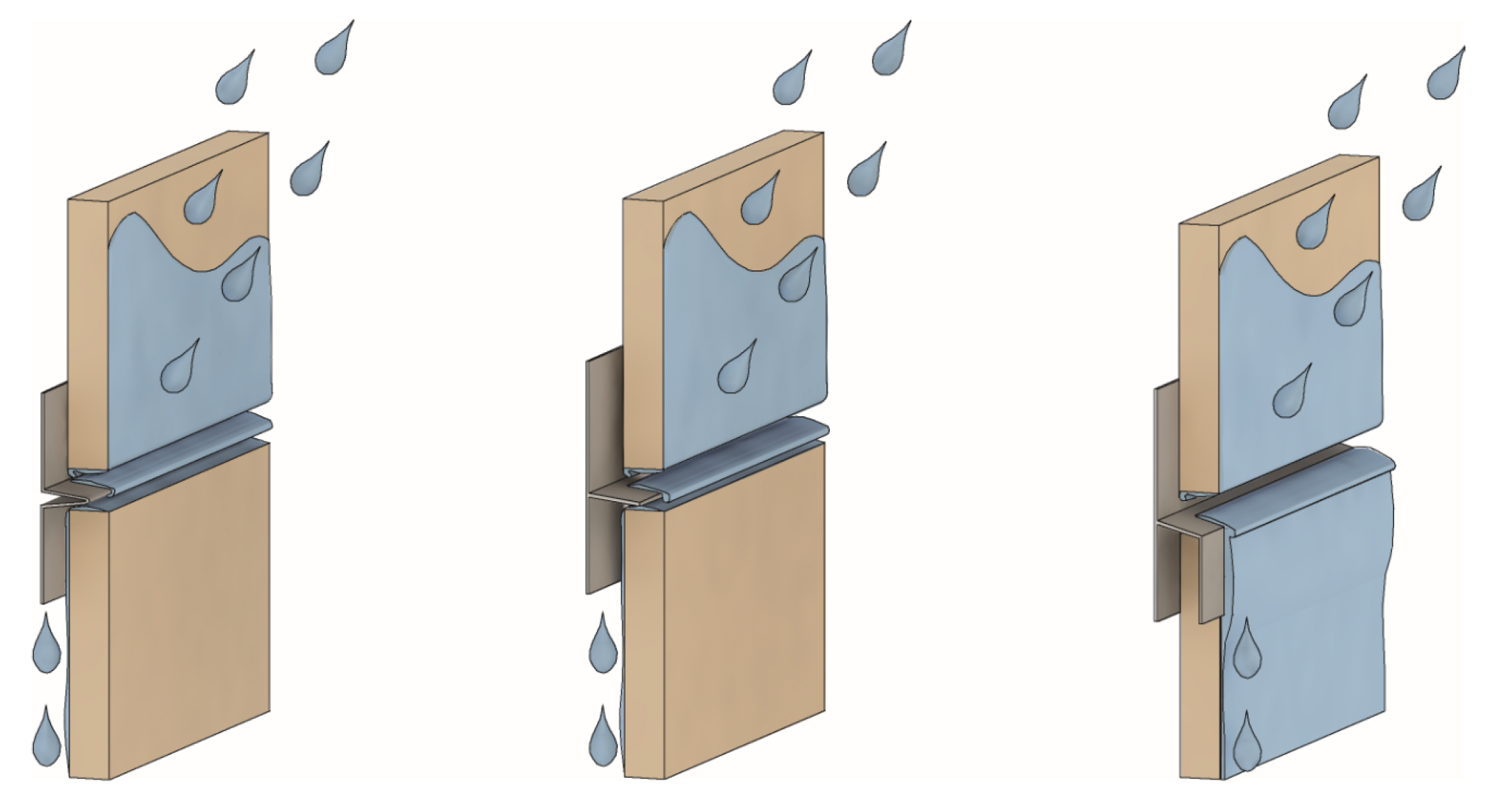
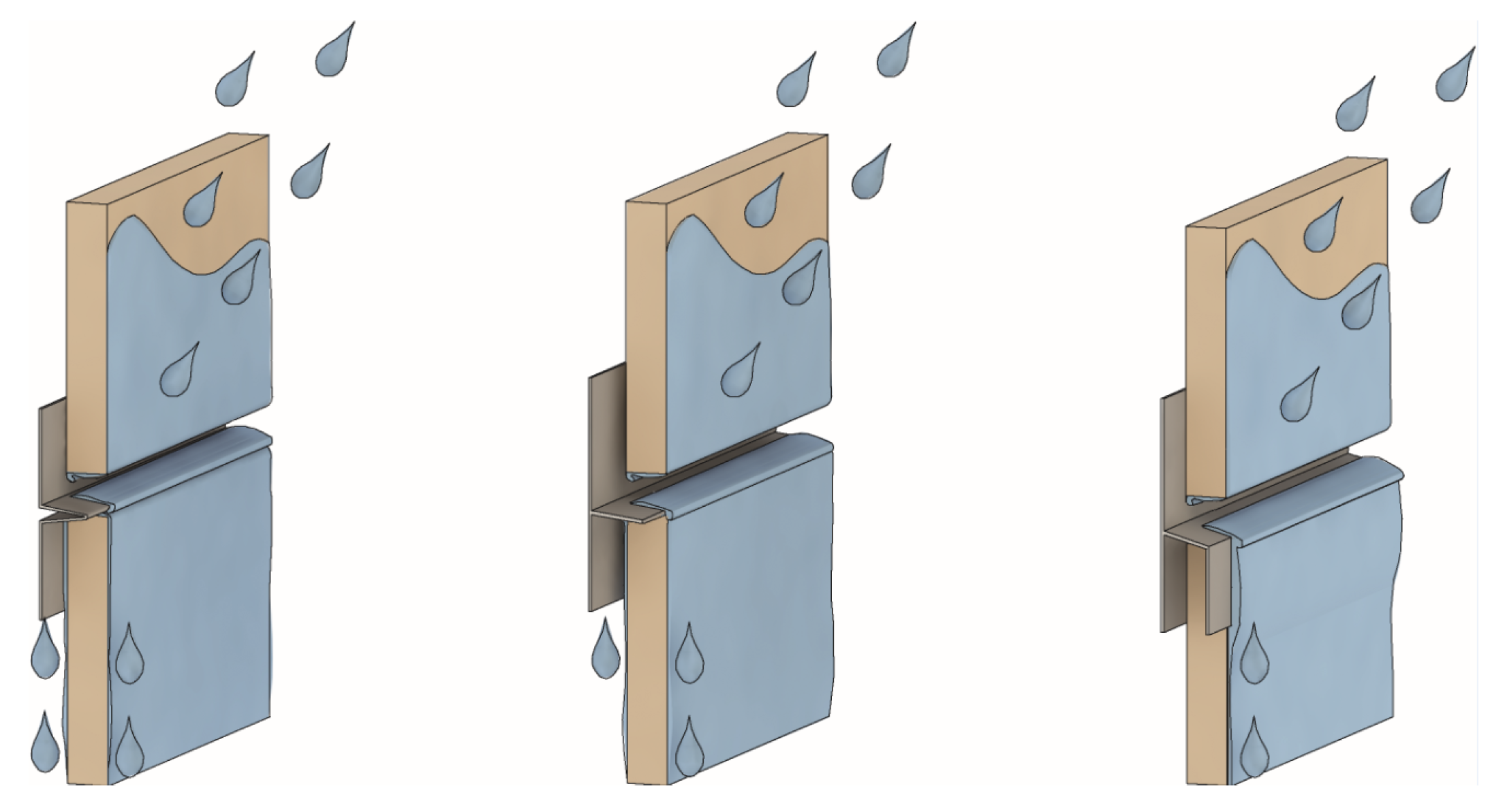
| Keyword or Phrase | AND | NOT |
|---|---|---|
| Façade OR | “Rain penetration” OR | CFD |
| “Façade cladding” OR | “Driving rain” OR | |
| “Panel cladding” OR | “Water penetration” OR | |
| “Panel façade” OR | “Water intrusion” OR | |
| Laboratory OR | “Wind-driven rain” OR | |
| Walls OR | WDR OR | |
| “Panel frame façade” OR | Laboratory OR | |
| “Exterior walls” OR | “Laboratory test” OR | |
| “External cladding” OR | “Open joint” OR | |
| Junction |
| HPL | Glass Fiber Smooth | Glass Fiber Rough | Fiber Cement White | Fiber Cement Grey | |||||||||||
|---|---|---|---|---|---|---|---|---|---|---|---|---|---|---|---|
| 3 mm | 5 mm | 8 mm | 3 mm | 5 mm | 8 mm | 3 mm | 5 mm | 8 mm | 3 mm | 5 mm | 8 mm | 3 mm | 5 mm | 8 mm | |
| Open joint | X | X | X | X | X | X | X | X | X | X | X | X | X | X | |
| T1-profile | X | X | X | X | X | X | |||||||||
| T2-profile | X | X | X | X | X | X | |||||||||
| h-profile | X | X | |||||||||||||
| Sealed top joint | X | X | X | X | X | X | |||||||||
| Gasket | X | X | |||||||||||||
| U-batten | X | X | X | X | |||||||||||
| U-batten with extra FP | X | X | X | X | |||||||||||
| U-batten with gasket | X | X | X | X | |||||||||||
| U with gasket and extra FP | X | X | X | X | |||||||||||
| Bevelled top 15 | X | X | X | X | |||||||||||
| Bevelled top 30 | X | X | X | X | |||||||||||
| Bevelled top 45 | X | X | |||||||||||||
| Bevelled both 15 | X | X | X | X | |||||||||||
| Bevelled both 30 | X | X | X | X | |||||||||||
| Bevelled both 45 | X | X | |||||||||||||
| Material/Name | Surface Characteristics | Dimensions [mm × mm × mm] | Recommended Joint Width [mm] |
|---|---|---|---|
| Glass Fiber Smooth | Painted and very smooth | 1195 × 840 × 6 | 5 |
| Glass Fiber Rough | Crushed stone and very rough | 1195 × 840 × 6 | 5 |
| Fiber Cement Grey | Painted and smooth | 1192 × 800 × 8 | 5 |
| Fiber Cement White | Sandblasted and rough | 1192 × 800 × 8 | 5 |
| HPL | Painted and very smooth | 1200 × 800 × 8 | 8 |
Publisher’s Note: MDPI stays neutral with regard to jurisdictional claims in published maps and institutional affiliations. |
© 2022 by the authors. Licensee MDPI, Basel, Switzerland. This article is an open access article distributed under the terms and conditions of the Creative Commons Attribution (CC BY) license (https://creativecommons.org/licenses/by/4.0/).
Share and Cite
Støver, E.A.; Sundsøy, M.H.; Andenæs, E.; Geving, S.; Kvande, T. Rain Intrusion through Horizontal Joints in Façade Panel Systems—Experimental Investigation. Buildings 2022, 12, 1497. https://doi.org/10.3390/buildings12101497
Støver EA, Sundsøy MH, Andenæs E, Geving S, Kvande T. Rain Intrusion through Horizontal Joints in Façade Panel Systems—Experimental Investigation. Buildings. 2022; 12(10):1497. https://doi.org/10.3390/buildings12101497
Chicago/Turabian StyleStøver, Eva Armstrong, Marte Haugen Sundsøy, Erlend Andenæs, Stig Geving, and Tore Kvande. 2022. "Rain Intrusion through Horizontal Joints in Façade Panel Systems—Experimental Investigation" Buildings 12, no. 10: 1497. https://doi.org/10.3390/buildings12101497





